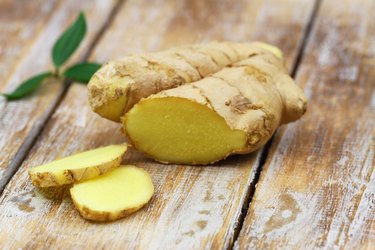
Ginger root has a warm, spicy flavor that can make a diverse range of dishes even more delicious, from savory stir fries to delightful desserts. It's also inexpensive and easy to store in addition to being a superfood, making it a household staple that every cook should have in his arsenal.
What about the slightly wrinkled, half used or kind of old piece of ginger root that's been hanging out in your fridge for a few weeks? Will that add punch to your dish, or is it garbage can fodder? Take a closer look at how you can tell the difference between fresh, safe ginger root and ginger root that has gone bad.
Video of the Day
Video of the Day
How to Tell if Ginger Root Is Fresh
Ginger is the root of a vegetable. It has a brown outer layer and a yellow to tan inner flesh, so don't worry if the outside looks dull or brown (imagine a potato). A really fresh and great ginger root will be firm and taut, with a moist, bright inner flesh. The smell will be fresh and bright.
However, slightly less-fresh pieces of ginger are still fine for cooking. It's OK if parts of the root give a little under pressure or are wrinkled slightly at the tips. It's also OK if parts of the root's flesh are a bit discolored or bruised. Just consider cutting away and not using the less-fresh ends in these cases, as they won't be as flavorful. Fresh ginger is better, but not-as-fresh ginger is totally fine.
How to Tell if Ginger Root Has Gone Bad
You don't want to cook or consume rotten ginger. It's not going to taste good, and in some instances, it could make you sick.
You can tell ginger root has gone bad if it is dull yellow or brown inside and especially if it looks gray or has black rings on its flesh. Bad ginger is also dry and atrophied and can be either mushy or brittle. You can search for pictures of bad ginger online for a comparison.
Rotten ginger will not smell strongly of ginger and may not smell like much of anything at all. If it has gotten mushy or moldy, it could smell rotten or off.
Identifying Moldy Ginger
In addition to rotting, ginger root can also suffer from mold. Mold usually appears at places where you've cut off pieces of ginger in the past and exposed the flesh of the root. It can appear in a variety of colors, including white, black or green. Any color that's not brown, yellow or tan is suspect. Throw away moldy ginger.
About Blue Ginger
In Hawaii, there's a strain of ginger called "blue ginger." This root contains flesh with a blue hue and might also display blue rings. If you've purchased blue ginger, don't worry — it's perfectly good. The fresh smell and moist flesh should confirm that for you.
Shelf Life of Ginger Root
On the counter or in the pantry, a piece of uncut ginger root will last about a week. In the fridge, when properly stored, it will last up to a month. After peeling or dicing your ginger, it will last a few hours at room temperature or about a week in the fridge when stored in an airtight container.
To store your ginger even longer, consider freezing or pickling your ginger. Freezing or pickling your ginger increases its shelf life to about three months.
How to Store Ginger Root
If you're going to use your ginger root in a day or two, you can leave it on your counter, in your fruit bowl or in the pantry without an issue.
If you want to store your ginger for longer or have a piece of leftover ginger, store it in the fridge, lightly wrapped in a cloth or paper towel and then placed in a container or sandwich bag. You can store it either in the crisper or the main part of the fridge.
If you have a large chunk of ginger, just cut off the part you're going to use and don't peel the entire root. Keeping the skin on the root helps preserve it for longer.